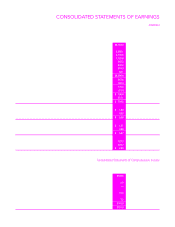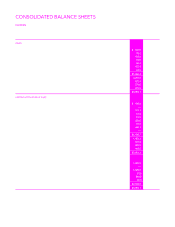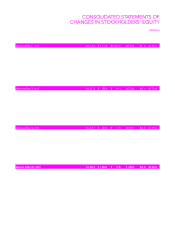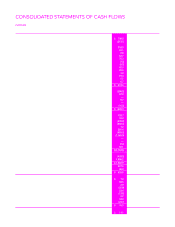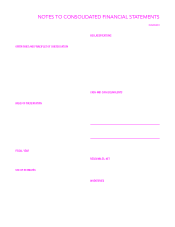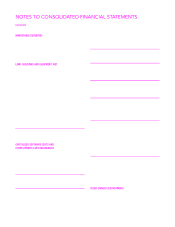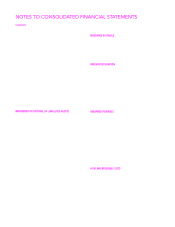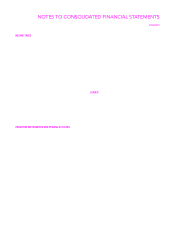Red Lobster 2015 Annual Report Download - page 39
Download and view the complete annual report
Please find page 39 of the 2015 Red Lobster annual report below. You can navigate through the pages in the report by either clicking on the pages listed below, or by using the keyword search tool below to find specific information within the annual report.
DARDEN RESTAURANTS, INC. | 2015 ANNUAL REPORT 35
NOTES TO CONSOLIDATED FINANCIAL STATEMENTS
DARDEN
INCOME TAXES
We provide for federal and state income taxes currently payable as well as for
those deferred because of temporary differences between reporting income
and expenses for financial statement purposes versus tax purposes. Federal
income tax credits are recorded as a reduction of income taxes. Deferred tax
assets and liabilities are recognized for the future tax consequences attribut-
able to differences between the financial statement carrying amounts of
existing assets and liabilities and their respective tax bases. Deferred tax
assets and liabilities are measured using enacted tax rates expected to apply
to taxable income in the years in which those temporary differences are
expected to be recovered or settled. The effect on deferred tax assets and
liabilities of a change in tax rates is recognized in earnings in the period that
includes the enactment date. Interest recognized on reserves for uncertain tax
positions is included in interest, net in our consolidated statements of earnings.
A corresponding liability for accrued interest is included as a component of
other current liabilities on our consolidated balance sheets. Penalties, when
incurred, are recognized in general and administrative expenses.
ASC Topic 740, Income Taxes, requires that a position taken or expected
to be taken in a tax return be recognized (or derecognized) in the financial
statements when it is more likely than not (i.e., a likelihood of more than
50 percent) that the position would be sustained upon examination by tax
authorities. A recognized tax position is then measured at the largest amount
of benefit that is greater than 50 percent likely of being realized upon ultimate
settlement. See Note 16 – Income Taxes for additional information.
Income tax benefits credited to equity relate to tax benefits associated
with amounts that are deductible for income tax purposes but do not affect
earnings. These benefits are principally generated from employee exercises
of non-qualified stock options and vesting of employee restricted stock awards.
DERIVATIVE INSTRUMENTS AND HEDGING ACTIVITIES
We enter into derivative instruments for risk management purposes only,
including derivatives designated as hedging instruments as required by FASB
ASC Topic 815, Derivatives and Hedging, and those utilized as economic
hedges. We use financial and commodities derivatives to manage interest
rate, compensation, commodities pricing and foreign currency exchange rate
risks inherent in our business operations. Our use of derivative instruments
is currently limited to interest rate hedges; and equity forwards contracts.
These instruments are generally structured as hedges of the variability of
cash flows related to forecasted transactions (cash flow hedges). However,
we do at times enter into instruments designated as fair value hedges to
reduce our exposure to changes in fair value of the related hedged item. We
do not enter into derivative instruments for trading or speculative purposes,
where changes in the cash flows or fair value of the derivative are not expected
to offset changes in cash flows or fair value of the hedged item. However, we
have entered into equity forwards to economically hedge changes in the fair
value of employee investments in our non-qualified deferred compensation
plan. All derivatives are recognized on the balance sheet at fair value. For
those derivative instruments for which we intend to elect hedge accounting,
on the date the derivative contract is entered into, we document all relationships
between hedging instruments and hedged items, as well as our risk-management
objective and strategy for undertaking the various hedge transactions. This
process includes linking all derivatives designated as cash flow hedges to
specific assets and liabilities on the consolidated balance sheet or to specific
forecasted transactions. We also formally assess, both at the hedge’s inception
and on an ongoing basis, whether the derivatives used in hedging transactions
are highly effective in offsetting changes in cash flows of hedged items.
To the extent our derivatives are effective in offsetting the variability of
the hedged cash flows, and otherwise meet the cash flow hedge accounting
criteria required by Topic 815 of the FASB ASC, changes in the derivatives’
fair value are not included in current earnings but are included in accumulated
other comprehensive income (loss), net of tax. These changes in fair value
will be reclassified into earnings at the time of the forecasted transaction.
Ineffectiveness measured in the hedging relationship is recorded currently in
earnings in the period in which it occurs. To the extent our derivatives are
effective in mitigating changes in fair value, and otherwise meet the fair value
hedge accounting criteria required by Topic 815 of the FASB ASC, gains and
losses in the derivatives’ fair value are included in current earnings, as are the
gains and losses of the related hedged item. To the extent the hedge accounting
criteria are not met, the derivative contracts are utilized as economic hedges
and changes in the fair value of such contracts are recorded currently in
earnings in the period in which they occur. Cash flows related to derivatives
are included in operating activities. See Note 10 – Derivative Instruments
and Hedging Activities for additional information.
LEASES
For operating leases, we recognize rent expense on a straight-line basis over
the expected lease term, including cancelable option periods where failure to
exercise the options would result in an economic penalty to the Company.
Differences between amounts paid and amounts expensed are recorded as
deferred rent. Capital leases are recorded as an asset and an obligation at
an amount equal to the present value of the minimum lease payments during
the lease term. Sale leasebacks are transactions through which we sell
assets (such as restaurant properties) at fair value and subsequently lease
them back. The resulting leases generally qualify and are accounted for as
operating leases. Financing leases are generally the product of a failed sale-
leaseback transaction and result in retention of the “sold” assets within land,
building and equipment with a financing lease obligation equal to the amount
of proceeds received recorded as a component of other liabilities on our
consolidated balance sheets.
Within the provisions of certain of our leases, there are rent holidays and
escalations in payments over the base lease term, as well as renewal periods.
The effects of the holidays and escalations have been reflected in rent expense
on a straight-line basis over the expected lease term, which includes cancel-
able option periods where failure to exercise such options would result in an
economic penalty to the Company. The lease term commences on the date
when we have the right to control the use of the leased property, which is
typically before rent payments are due under the terms of the lease. Many
of our leases have renewal periods totaling 5 to 20 years, exercisable at our
option and require payment of property taxes, insurance and maintenance
costs in addition to the rent payments. The consolidated financial statements
reflect the same lease term for amortizing leasehold improvements as we use
to determine capital versus operating lease classifications and in calculating
straight-line rent expense for each restaurant. Percentage rent expense is
generally based on sales levels and is accrued at the point in time we determine
that it is probable that such sales levels will be achieved. Amortization expense
related to capital leases is included in depreciation and amortization expense
in our consolidated statements of earnings. Landlord allowances are recorded
based on contractual terms and are included in accounts receivable, net and
as a deferred rent liability and amortized as a reduction of rent expense on a
straight-line basis over the expected lease term.




